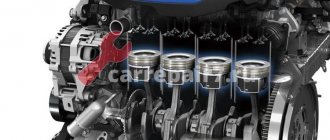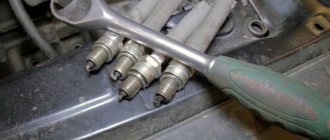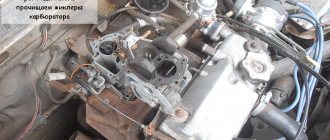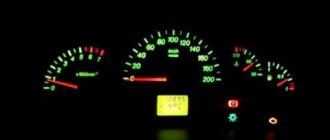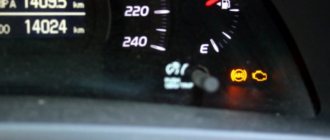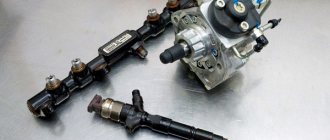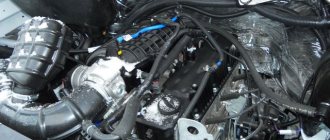Main reasons
There is a fine line on the engines of any car brand between floating speed and tripping. These two cases can be combined into one fault, but also be completely different. But in most cases, the speed starts to jump precisely because one of the cylinders loses its efficiency. The engine management system basically has only one function: maintaining idle speed and protecting the environment from the release of toxic gases from the car. Idle speed is regulated by the bypass channel of the throttle assembly, in the path of which an idle speed regulator is installed. When the engine stalls, the control system tries to equalize the efficiency of the bad cylinder by opening the bypass channel, thereby adding air and increasing the opening time of the injectors. This is done in order to facilitate the combustion process of the fuel-air mixture. After all, if fuel is thrown outside at idle, environmental standards will not be observed. As a result, the car’s brain critically adds air and the revs fluctuate, causing the engine to fluctuate.
Why does the engine stall when it’s hot?
Cracks
Cracks in the cylinder head or block are one of the most common causes of hot running. Metal, as is known, expands with increasing temperature; accordingly, small cracks can increase and allow little coolant to pass into the combustion chamber. This will interfere with the normal combustion of the mixture in the cylinder, and the engine will stall when warming up. The same effect occurs when a crack in the gasket under the block head expands and burns out.
Particular attention should be paid to motors with manual valve adjustment. The clearances must be set according to the manual for this type of engine; this cannot be ignored. If the valve is clamped, it will not close completely, the tightness in the combustion chamber is lost and the cylinder does not work when heated. If the gaps are set incorrectly, the valve itself and the seat burn out, it sinks into the head and the process becomes irreversible.
Wobbly piston rings also cause unbalanced engine operation when hot. Thermal changes in the metal, uneven wear, and engine overheating also play a role here. Runout of the camshaft journals leads to engine imbalance. The engine heats up and shakes, stalls periodically, and characteristic knocking noises appear.
ECM violation
In car electronics, the same problem with materials expansion exists. Boards, contacts, connectors are all subject to temperature changes. The quality of the materials themselves plays a big role here. Even a trivially extended contact on one of the coils or injector connector can cause the engine to trip on a warm car. Or a poor connection on the mass air flow sensor can cause the car to stall.
It's all about contacts. Here's another example. A common occurrence is the tripping of an eight-valve VAZ engine when hot due to a shorted ignition coil. The primary circuit overheats and does not produce a spark to one of the channels.
On a Kalina car, the electronic unit is located under the heater, or rather under the heater hose. With mileage, the clamp relaxes and antifreeze begins to drip, getting onto the block. It does not appear immediately, but when it heats up, the machine begins to trip due to a violation of the integrity of the tracks on the board.
Gasoline pump and its secrets
A malfunction associated with this miracle part is not always easy to find. You have to connect a pressure gauge to the injector rail, place it on the windshield and drive around, checking the fuel pressure as you go. This difficulty is associated with floating tripping on a hot one, if it does not always appear or only during movement. As it heats up, the rotor in the fuel pump begins to turn, the pressure drops and the engine runs rough. Trite and simple.
Worn needle valve and the presence of slag in the injectors can cause throbbing on a warm engine when starting. The fault can be quickly found using an oscilloscope. For example, using Andrey Shulgin’s script on Postolovsky’s engine tester, you can easily determine the contribution of each individual cylinder to engine operation. Literally in a matter of seconds, identify a non-working injector or a burnt out valve.
If an injection engine throttles or stalls when heated, there can be a great many reasons. You need to deal with each of them sequentially, mutually excluding one after the other. Using this article, having written down the main points for yourself, you can easily follow them yourself or in a car service when diagnosing. The main thing is not to immediately buy expensive spare parts, listen to a lot of advice and change everything. Trust the professionals, knowing the minimum theory of finding the reasons for the engine not running smoothly.
Source
The main causes of problematic engine starting
If the car has served its owner faithfully for more than one year, some systems and parts may well fail. A fairly common phenomenon that plagues modern vehicles is the situation when the engine stalls after starting, and repeated subsequent attempts to start the car are unsuccessful.
Is this annoying symptom evidence of a serious malfunction that requires the intervention of professional mechanics, or can you do it yourself?
First, we need to identify the reason for such uncharacteristic behavior of the iron horse. Experts note several prerequisites that make it possible to determine why the engine stalls. In addition to the most obvious reasons, such as unexpectedly running out of gasoline or frozen diesel fuel, there are more hidden ones that can be eliminated by simple repairs of individual parts or components. Let's look at the most common ones in more detail.
Anti-theft device
It should be noted that, to the delight of careless motorists, the probable cause of the engine failure to function normally after starting is simple forgetfulness.
Failure to press the motion lock button on the anti-theft system in time results in the car not receiving a timely signal about the presence of the owner in the cabin, and the running engine stalls. Having corrected this oversight, you can continue on your way without hindrance, since the engine starts smoothly and runs smoothly.
Problems with the idle speed valve
Here, a possible reason causing the engine to refuse to operate normally some time after starting may be not only a malfunction of the device in question, but also its contamination. A clogged valve causes the unit to stall after a short time.
By cleaning this device in a timely manner, you can protect your car from annoying problems when starting the engine.
A layer of waste accumulated during operation prevents the throttle from opening evenly, which disrupts the trouble-free functioning of the engine. In addition, unwanted contamination contributes to the corruption of sensor data, thereby leading to system failure.
Poor quality fuel
It is known that for the normal functioning of all vehicle mechanisms it is necessary to provide it with suitable fuel in a timely manner. Poor quality fuel poured into the tank contributes to rapid clogging of the fuel system.
Clogged filters prevent the engine from providing the fuel-air mixture in a timely manner, which negatively affects the functionality of the engine, significantly reducing its power. Rapid wear of vital vehicle components is caused by unwanted deposits on the valves. This also affects the ability of the motor to provide the required power.
In other words, another reason that forces the engine to behave inappropriately when starting is the clogging of the fuel filters located directly in front of the pump that supplies the unit with fuel.
Irregularities in the lubrication system
It should be noted that most car components require regular lubrication. The proper functioning of the engine directly depends on the quality of periodically replaced oil.
You should not save money by using already used motor lubricant, since the slag accumulated during operation can clog the pump, preventing it from fulfilling its intended purpose. The same applies to unwanted impurities, often present in low-quality oil.
Therefore, it is recommended to approach the choice of motor oil with extreme responsibility, giving preference to trusted manufacturers. In addition, an important condition for ensuring the normal operation of all vehicle components is the timely replacement of used lubricant.
Air lock in the fuel supply system
This rather unpleasant reason for the engine’s failure to perform its intended functions in its initial stage prevents the normal supply of fuel to the unit, which negatively affects the engine power.
The last stage of development of the problem under consideration is characterized by a complete cessation of fuel supply. Of course, the engine, deprived of power, stops doing its job, which forces it to suddenly stall even before the car starts moving.
Every car enthusiast can eliminate an airlock on his own. This does not require any special knowledge or skills. Using a manual fuel pump, all air is finally expelled from the fuel system. It is recommended to complete the troubleshooting by checking the tightness of the pipeline and the ability of the engine to start when cold.
Pump fault
If the fuel pump gradually becomes unusable, this will primarily negatively affect the operation of the car engine. The final breakdown of such an important part will not allow the engine to start at all. Partial failure of the pump allows the car to start for a very short time. A disruption in the normal fuel supply to the engine leads to engine shutdown.
You can cope with the problem by timely replacing an unusable fuel pump.
Electronics problems
Another reason that forces the engine to stall after a fairly short period of operation is the malfunction of some electronic devices. Basically, the problem in question is caused by problems with the following sensors:
- a device that transmits EGR data to the driver. The functional purpose of this device is to control the release of harmful substances into the external environment. The exhaust gas purification system fails when the sensor is clogged or faulty. Distortion of the data transmitted by the device does not allow the engine to start normally;
- Unsuitable oxygen and crankshaft position sensors also have a negative impact on the optimal operation of all vehicle mechanisms.
By replacing a faulty device, you can achieve complete restoration of engine functions. Misunderstandings with the launch will disappear.
Problems in the cleaning system
Among the likely causes of engine failure a short time after starting is clogged filters. The components that make up the vehicle cleaning system must be replaced in a timely manner.
The main cleaning elements responsible for the normal functioning of the fuel system are the air and fuel filters. It is strictly not recommended to allow them to become excessively clogged, since in the future it can lead to numerous problems.
Modern cars are often equipped with not two, but several filters. The cleaning system in such machines works much more efficiently, although its maintenance is slightly more complicated in proportion to the number of components.
The engine stalls when hot: causes and solutions
Some drivers have noticed that after warming up the engine begins to stall, that is, its power drops due to a malfunction of one of the internal combustion engine cylinders. In addition to a noticeable deterioration in speed characteristics, as the speed increases, you can notice body vibrations, significant fuel consumption and a variable number of idle speeds. Where this problem comes from and how to solve it needs to be clarified.
Five signs of tripling
It is very important that the fault is diagnosed in a timely manner. Then you need to isolate the problem as quickly as possible so that repairs can be made.
So, if the VAZ 2107 engine has trouble with the carburetor, the reason for this may be the malfunction of one of the cylinders. Sometimes several cylinders fail at once. In fact, this is due to the fact that for some reason the working mixture does not ignite in the combustion chamber of an idle cylinder, or it does not burn completely.
We list five signs of engine tripping in a VAZ:
- At idle, the engine begins to twitch and shake. Sometimes the shaking becomes so powerful that the vibrations are felt throughout the body, transmitted to the steering wheel and even to the gear lever. With such strong vibration, we are most likely talking about a complete failure of one of the cylinders.
- The engine power noticeably disappears, the driver feels the gas pedal sink, jerks appear during acceleration, and fuel consumption increases. The check engine light may come on. Of course, these problems also appear with other malfunctions. But this is exactly how tripling manifests itself.
- The engine speed begins to float or jump. RPM fluctuations can be either minor or quite large.
- If you look at the electrodes of the spark plugs, you will notice black carbon deposits. Of course, this may indicate a malfunction of the spark plug itself. But if, after changing the spark plug set, carbon deposits appear again in the near future, then there is another reason for the breakdown.
- The exhaust system begins to operate with sound “jerks” that transmit vibration to the body.
Even if you notice only one of these symptoms, you urgently need to understand what was the source of the breakdown. The point is that equipment failures cannot be ignored. After all, delay can lead to more serious problems that will require expensive repairs.
Spark plug
The main thing is that you cannot immediately determine why one of the cylinders failed. That is why even experienced car enthusiasts and experienced drivers can delve into the insides of their car all day long, but in the end they will not achieve any result. You have to check everything several times.
How can you speed up this procedure and pay attention to the most important problems. Most often, the engine stalls when warming up due to faulty spark plugs.
One of the causes of malfunction are spark plugs if:
The problem is this:
The solution to the problem is simple: you need to replace the entire set of spark plugs, and then check the remaining parts next to them for damage. Change the oil and start the engine. If the tripping has stopped, then everything has been done correctly; if not, we need to look for other sources of the problem.
Possible problem options
Further searching for the cause of the problem becomes more difficult, since you will have to check a dozen parts for damage:
That's all there is to inspect first. Next, you should go through and inspect the following parts for defects: carburetor, valve stem seals, valve rockers, air filter, entire ignition system, cylinder head gasket.
If it continues to malfunction after a detailed inspection of all parts and replacement of all damaged components, then you need to contact a service station for the help of specialists and computer diagnostics of the car. The cause of the malfunction is extremely difficult to find, so even finding it may take not several hours, but several days. In rare cases, even a trip to the service center may end in nothing.
How to check the wiring?
There is one, rather risky way to find the cylinder: disconnect the high-voltage cables from the running engine one by one. By disconnecting the power from the ignition, it will be possible to understand which of the cylinders is not working, thereby significantly narrowing the search.
However, there is a risk of electric shock. It is not fatal, but it is quite painful, so you need to take care of your protection. You can start working if you first put on rubber gloves and stand on a rubber mat. Then follow these tips:
Once the approximate location has been identified, it is necessary to sort through all the parts associated with this cylinder. Damage can even be a small breakdown of the hose or peeling of the insulation on the wiring.
It is recommended to check the entire system:
List of possible problems
Problem. After filling up with new gasoline, the check engine light started to come on, the car managed to warm up, but it started to stall after about 20-30 minutes of driving. Answer. In this case, it is not the ignition; the power supply and gas distribution system can also be discarded. It is necessary to check the integrity of the carburetor and fuel supply system. Replacing gasoline sometimes does not solve the problem.
This happens in some foreign cars with automatic transmissions. If you can’t find anything on your own, you should go to a service station; computer diagnostics should reveal the problem. There is no need to agree to replacing components without a reason, if the option will only possibly solve the problem. It is recommended to visit another service station.
Problem. Gasoline engine, injection type, misfires are shown in different cylinders during diagnostics. The spark plugs were replaced, all parts of the gas distribution system were cleaned and checked. Answer. The breakdown may be in the distributor cover or the ignition power supply: wiring, coils. It remains to check the fuel system as well.
Engine tripping is a very unpleasant defect that is difficult to get rid of. It is necessary to check all the above components, replace damaged parts - perhaps this will solve the problem. If all attempts are in vain, then you should go to a service station for diagnostics.
Source
Why does the engine stall when hot?
When the engine stalls when hot, there may be several reasons. We'll look at them all below. Characteristic symptoms: the car engine starts normally, but after warming up it starts to stall. In this case, it usually does not matter whether the engine is running at idle speed or under load (while moving); as a rule, tripping begins spontaneously and spontaneously disappears. After stopping and cooling, it starts normally, but after reaching operating temperature, failures in the operation of the cylinders again appear. Let's consider possible malfunctions that lead to this behavior of gasoline engines.
The engine heats up and starts to stall: why does this happen?
Almost every car enthusiast sooner or later encounters such a fairly common malfunction of the internal combustion engine, when the engine stalls. As a rule, in certain situations the engine stalls when hot or only when cold, and tripping can also occur constantly (regardless of the temperature of the power unit, operating mode, load level, etc.).
In short, engine tripping means that one or more cylinders are not firing, and there can be several reasons for such a malfunction. In this article we will talk about why the engine stalls after warming up, how the malfunction can be diagnosed, and what signs help to accurately identify the problem.
Why the engine stalls when hot - diagnostic algorithm
By following these instructions, you can find the cause of the problem and repair your car yourself.
Spark plug
Remove the high-voltage wires from the spark plugs and unscrew the spark plugs. Inspect contacts and insulators. Contacts and insulators of serviceable spark plugs must be dry. If they are covered with oil (“wet”), we have a probable cause of “triple”.
Spark plugs become “wet” if the oil entering the combustion chamber when lubricating the cylinder-piston group does not burn. For one of two reasons: 1. Too much oil gets into the combustion chamber. 2. The fuel mixture in the combustion chamber does not ignite or does not burn completely. Often both causes are present simultaneously, or one as a consequence of the other. That is, too much oil gets into the combustion chamber, the spark plug contacts become dirty, a spark does not occur or it is weak, the fuel does not ignite (or does not burn completely). Or vice versa. There is no spark, the fuel does not burn, the contacts become oily. An important feature is that the contacts of all spark plugs, or just one, are oiled.
Step by step
- Check the engine oil level. Perhaps its level is higher than normal. Without considering the unpleasant case of a breakthrough of coolant into the crankcase (here the symptoms will be somewhat different) - most likely it was simply overfilled. As a result, the oil pressure in the engine is higher than normal, the excess enters the combustion chamber, the contacts become oily, and the spark periodically disappears from one or more spark plugs. Check the crankcase breather (ventilation) hose: it may be clogged with dirt, frozen condensate (in winter), simply bent or incorrectly installed. The results are the same. In principle, these reasons should be accompanied by indecently high oil pressure in the engine, which can be seen on the dashboard, but... The sensor (light) may simply be faulty and not show this. In this case, if the tripping disappears after draining the excess and cleaning the ventilation, the sensor (light bulb) must be replaced. The spark plugs do not match the engine type (too cold). And don’t think that the markings on the candles and what’s written in the “books” are the ultimate truth. This is checked by installing a set of spark plugs that is known to work (from another car) and checking the operation of the engine on them. If there is no friction, change the spark plugs. New spark plugs are not a panacea here - they may also turn out to be faulty or not suitable for their specifications. Power system malfunction. If the engine is equipped with self-diagnosis, perform it. If not, take it to the service station. Most likely there is a failure in one of the sensors or controllers: lambda probe, DVRM sensor, WTi regulator, you never know... In “smart” engines, even incorrect readings of the coolant temperature sensor can lead to tripling. The controller incorrectly calculates the fuel supply parameters, over-enriches the mixture and... as a result, the spark plugs are “flooded”.
avtoexperts.ru
One of the most common engine malfunctions is interruptions in the operation of one or more of its cylinders, which among motorists is referred to as “troubling the engine.” Anyone who has encountered this phenomenon is probably familiar with its symptoms. But not all car enthusiasts know what the causes and consequences of such a breakdown are. Today we will tell you in detail why the engine misfires, how to diagnose and properly repair the engine.
Reasons why the engine “troubles”
The engine may throb constantly or from time to time. General signs of engine vibration are as follows: at idle speed, strong uneven vibrations begin to penetrate from the engine compartment into the cabin, the sound of the running engine changes (it “growls”, goes from high “notes” to low ones, and back). The unit begins to consume more fuel, and its power decreases, and obscene sounds are heard from the exhaust pipe, accompanied by thick white or black smoke. If at least one of these signs is present, it means that the “heart” of your car has problems with one or more cylinders. If they are not eliminated in time, the consequences can be very disastrous - up to and including a major overhaul of the power unit.
Will be useful: Pros and cons of a turbocharged gasoline engine
Let's characterize the most common reasons why an engine stalls - there are four of them:
- late or early ignition of the air-fuel mixture (FA);
- uneven entry of fuel into the engine cylinder;
- lack or excess of air in the combustion chamber of the cylinder;
- drop in compression level.
Let's take a closer look at them.
Reason #1
. If the air-fuel mixture ignites in the cylinder earlier or later than the specified period, then the spark plugs are to blame, which produce too weak a spark, or the formation of a spark occurs untimely. Weak sparking occurs due to the fact that harmful deposits (carbon deposits) accumulate on the spark plug body and its electrodes, which interfere with spark breakdown.
Another reason for a weak spark is the destruction of its insulator. In the place where the insulator has collapsed, a soot spot forms, which prevents the formation of a normal spark. If there is no spark at all, then there may be several reasons: a worn spark plug cap, a failed high-voltage wire (supplies current to the spark plug), a breakdown of the ignition coils or switch. The latter phenomenon is quite rare, but it would not be superfluous to check the condition of the switch, which controls the ignition distribution.
Reason #2
. Uneven entry of fuel into the cylinder, when a smaller amount of gasoline or diesel is poured into the combustion chamber, often occurs due to a malfunction of the fuel pump parts (pressure part or pressure reducing valve) or the pressure valve in the fuel supply system. If more fuel than necessary gets into the cylinder, the problem probably lies in the fuel injectors - they are dirty or out of order. Finally, another “fuel” reason for engine throttling is a malfunction of the electronic control unit (ECU) of the power unit, which can erroneously increase or decrease the supply of gasoline/diesel to the cylinder.
Reason #3
. Excess air in the cylinder is a sign of depressurization of the air supply system, which includes the air filter, intake pipe hose, throttle pipe and receiver. A lack of this important component of the air-fuel mixture in the cylinder can be caused by a dirty air filter or broken throttle valves.
A malfunction of the mass air flow sensor or throttle position sensor, which the ECU perceives as a request from the engine to add or reduce the amount of air into the combustion chamber, can also cause the engine to trip.
Reason #4
. Low compression or its complete absence is perhaps the most serious reason why an engine misfires. This is the first sign that the pistons or valve in an idle cylinder are burnt out, or the piston rings are completely worn out. This cannot be done without serious repairs to the power unit.
In addition to the common reasons why an engine misfires, there are also secondary ones. They are spoken of when the engine starts to run periodically - “cold” (at idle speed) or “hot” (at medium or high speed). The most common malfunction here is the valves: when their gap increases at idle speed, the engine starts to trip, which goes away as it warms up (the gap is restored). And vice versa, the gap increases when the engine reaches operating temperatures - that’s when it starts “hot” with all the signs described above.
Diagnostic methods
If all the signs that the engine is malfunctioning are present, it is necessary to diagnose it and determine which cylinder has failed and for what reason. You can carry out the check yourself, or you can take the car to a service station, where its power unit will be subjected to detailed computer diagnostics. In most cases, you can determine the reason for the engine tripping yourself, but if the cylinder refuses to work, for example, due to low compression, it is better to seek help from an experienced mechanic.
Step 1.
Determine the problem cylinder. We check the operation of the cylinders with the engine running, so all safety measures must be observed. We turn on the ignition, open the hood, listen to the engine. We remember what sound it works with. We begin to disconnect the high-voltage wires going to the spark plugs one by one.
When the working cylinder is turned off, the engine begins to rev with double force. If you disconnect the spark plug on the non-working cylinder, the behavior of the engine will not change. Another way is to not touch the high-voltage wires, but one by one turn off the chips that control the supply of fuel from the injectors to the cylinders. If one of the chips is turned off, the operation of the engine will not change - this is how we detect a malfunctioning cylinder.
Step 2.
We check the condition of the high-voltage wire and spark plug. We disconnect the high-voltage wire and carefully inspect it. If we notice damage to the insulating layer, it means that the cause of the malfunction is in the wire. It would also be useful to check the integrity of the current-carrying core - if it is broken or burnt out, then a breakdown or internal resistance occurs (we measure it with a multimeter, check it with normal readings), which interferes with the normal supply of current to the spark plug. But if the wire is intact, then the problem is in the spark plug. You need to unscrew it and inspect it carefully.
If you find visible damage to the spark plug base or its electrodes (carbon deposits), it will have to be replaced. If the spark plug is intact, we look for the problem that is causing the engine to continue to stall.
Step 3.
We measure whether enough air enters the cylinder. The lack of air enriches the fuel assembly, which leads to engine tripping. We check the tightness of the air supply system: close the inlet pipe, use a compressor to supply air into the cylinder at a pressure of 0.5-0.7 atm through a vacuum hose, and listen. If a characteristic hissing sound is heard, it means that the air supply system has become depressurized. Another diagnostic method is to check the air filter. If it is clogged, little air enters the cylinder. We diagnose the throttle sensor and the mass air supply sensor - for this you will need a laptop, which we connect to the diagnostic connector.
Step 4
. We determine how much fuel enters the cylinder. To do this, we measure the pressure in the fuel system with a pressure gauge (up to 7 atm), which we attach to the injector ramp. The pressure must be measured in 4 stages: when the ignition is turned on, at idle speed, at operating speed with the tube removed from the fuel pressure regulator and with the check valve tube pinched. If it is low, then the elements of the fuel pump or pressure valve in the fuel supply system have probably failed. If it’s normal, we check the condition of the injectors; they may become dirty or even fail. Finally, we check the operation of the fuel system using diagnostic equipment - errors in the ECU are possible.
Step 5.
We measure the compression in the cylinder using a compression gauge, which we insert into the spark plug hole of the problem cylinder, turn on the ignition and increase the engine speed. We take readings several times. If compression drops by 15%, then the piston, valves or piston rings in the cylinder are worn out. To determine this failure, you will have to disassemble the engine.
Power system diagnostics
The engine is running hot, the reason is that only one spark plug is “wet”, and the rest are “dry”.
- If the tripping continues, swap the “dry” and “wet” spark plugs. Check, unscrew the spark plugs. If a dry spark plug remains dry and a wet spark plug stays wet, the cause is the spark plug. Replace the faulty (“wet”) one with a serviceable one. If the “dry” has become “wet”, and the “wet” has become “dry”, we return to the high-voltage wire. We replace it with a good one and check it. Important: specifically for a tested and working one, and not for a new one. No one has yet canceled a factory defect. If this does not help, we move on to the ignition system. In older engine models, high-voltage wires were connected to the ignition distributor (distributor); in new ones, each cylinder (or pair) is equipped with an individual ignition coil. Dry the distributor cover, clean and adjust the contacts, or replace it entirely. Well, a spare distributor cap in an old car should be a must, like a first aid kit with a fire extinguisher. In new engines, swap the ignition coils from adjacent cylinders. Naturally, wires too. Check it out. If necessary, replace the faulty coil.
It should be noted that checking for a spark with a spark plug removed from the engine does not help much. Such a common reason as the failure of an individual ignition coil of a modern engine may lie not only in the absence of a spark, but also in its weak strength. Or in general - the power of the spark is excellent, but... when the coil heats up, either the power of the spark drops, or its combustion phase “floats” and it does not ignite the fuel mixture. Why should the performance of an individual ignition coil be checked experimentally, and not according to self-diagnosis and engine tests: diagnostics and self-diagnosis will not show malfunctions of a “dying” coil, that is, a coil that periodically operates in abnormal mode. It can “die” for a year, and self-diagnosis will consider it normal all this time - after all, during the test it shows the norm... As practice shows, it is the abnormal operation of the individual ignition coil that most often leads to “hot” engine tripping.
Source
The engine stalls when hot: reasons
Even experienced car owners, when faced with the fact that the engine is running hot, without showing signs of a major malfunction until it warms up completely, first of all blame the fuel or spark plugs. In addition to these options, there are several more less obvious reasons why the car runs smoothly when cold, but when the engine warms up it starts to throttle: low compression, electronic failure, fuel shortage due to wear of one or more injectors. To find out where to look for a specific source of the problem, you need to carry out a series of manipulations.
Typical reasons why a warm engine stalls
For a gasoline engine, there are usually three reasons leading to disruption of the cycle of a cylinder (or several):
For a diesel engine, this list is even shorter: insufficient compression, deficiency or ineffective fuel atomization.
Reasons for hot tripping in the internal combustion engine of a car:
The reason that engine problems begin when the engine is hot is often a malfunction of electronic components. Pressure, position, temperature, lambda sensors - their connectors, wires and fastenings - after spark plugs and ignition coils in a gasoline engine, in case of unstable engine operation - these are the first candidates for testing.
Engine control system components
For a chipped car, a malfunction can arise out of nowhere, due to a broken firmware. For most cars with distributed injection controlled by an ECU, resetting the firmware to factory settings or physically replacing the chip can get rid of the problem when the engine only stalls when hot.
How to find a fault
First of all, you need to find the cylinder that is interfering with the smooth operation of the engine. You can isolate a non-working cylinder on a gasoline engine by simply disconnecting the high-voltage wires, or “chips,” from the ignition control module. This is done while the engine is running, one at a time (one at a time, after returning the wire to its place). If after shutdown the general symptoms of the malfunction have not changed, it means that this cylinder is faulty. If it gets worse, it means this one works, look further.
For a diesel engine, the spark plugs of which play a role only during start-up and do not control the ignition, a “map” of working and non-working cylinders can be created by turning off the power to the piezo injectors. In the case of a mechanical fuel injection drive, the changed nature of the operation can be determined by noise - with a stethoscope, or by vibration, by touch, with a screwdriver.
Ignition system (petrol engine)
If the engine operates normally from the moment of starting for some time, but begins to stall after heating to operating temperature, this indicates that the quality of the spark at idle speed is satisfactory, but not at high speed. The reason for this, most often, is in one or more devices: the spark plugs themselves, high-voltage wires (armored wires), the ignition coil (it is an individual spark plug module), or a capacitor (if any).
Engine spark plugs and coils
Things to check:
If all the indicators are normal, sparking is in order, the spark plugs are not wet, sparks do not run through the wires, and nothing has changed due to the installation of serviceable parts - problems on the part of the ignition system are caused by a malfunction (or displacement) of the crankshaft position sensor.
Tips and tricks
Please note that in order to check the functionality of the ignition system, in some cases it is recommended to check the spark plugs for a spark. It is important to understand that if you simply unscrew the spark plug from the engine, the presence of a noticeable spark on the electrodes is not always a sign of complete service.
At the same time, checking the coils cannot be carried out by diagnostics or various tests, since in many cases the problem can be “floating”, and in the case of the test the readings will be normal. Finally, we note that practical operation identifies problems and malfunctions in the operation of ignition coils as one of the common causes of engine tripping after warming up.
In idle mode and at low speeds, the engine shakes: possible reasons for the unstable operation of the power unit. Self-diagnosis methods.
Why does the engine start to stall and the “check” light up on the dashboard: the main and most common reasons for the engine to stall and the “check” to light up.
For what reasons may misfire of the fuel-air mixture occur in one or more cylinders? Fault diagnosis, recommendations.
After switching to gas, the engine stalls, while running normally on gasoline: the main reasons for this malfunction. Diagnosis of problems, recommendations.
Engine trouble: symptoms. Why does tripping occur and how to find the reason why the motor starts to trip. Checking power, ignition, compression, etc.
Signs of a non-working cylinder (tribbing and vibration) of a diesel engine. Troubleshooting: compression, diesel injectors, glow plugs, injection pump and others.
Sensors and contacts
In modern engines (whether gasoline or diesel), the cycle is controlled by electronics: it changes the ratio in the fuel-air mixture, selects the ignition timing, and on some engines, the timing and angle of valve opening. All changes are based on the readings of numerous sensors. In addition to the serviceability of the device itself, the reliability of these readings is affected by the quality of the contact in the connector (chip), the integrity of the wires, the battery charge level and the voltage in the on-board network.
Indicators, due to malfunction of which the engine may start to stall when hot:
It often happens that a car’s engine starts to misfire because of one magnet and a piece of wire, and before the source of the problem was discovered, the car owner had already changed the spark plugs, injectors, or even the fuel pump.
If the car often starts when hot, in order to exclude a malfunction of one or more sensors, you need to carry out detailed computer diagnostics, or, if the car is “old” and is not equipped with a BC with a self-diagnosis system, sequentially remove the parts that are “in question” and check their connections , power supply, ring with an autotester.
The phenomenon of tripping in diesel engines
For diesel engines, the problem associated with tripping in cold mode is known firsthand, although in their case the range of possible causes is somewhat narrower.
Firstly
, the cause may be the presence of air.
Secondly
, problems may arise with the glow plugs.
Third
, the cold injector jams.
These are probably all the most common problems. However, we cannot exclude the possibility of problems with valve clearances, as well as timing marks and fuel injection pumps not set properly.
However, before you start checking and replacing everything, it is recommended to remember that “blind diagnostics” is not advisable for modern engines, since there are too many symptoms that are very similar to each other, typical for different malfunctions. In addition, a total replacement of everything that someone advises you may not bring the desired result. For this reason, it is best, if possible, to carry out computer diagnostics of the engine and, based on the results obtained, draw conclusions regarding the search for the causes of the malfunction.
Source
Malfunctions that cause a diesel engine to stall when hot
If you do not have the opportunity to do a detailed engine diagnostics, the main task is to understand whether the engine is trembling, or whether the engine is simply shaking from vibration. Make sure that the engine actually misfires by listening to the exhaust sound (uniform or not). Then, also by ear, determine the cylinder that is leaking. Swap its injector with the neighboring one. If another cylinder starts to fire, the problem is in the injector.
Checking diesel engine injectors
The smooth operation of a diesel engine mainly depends on the quality of the settings of the fuel equipment, therefore, first of all, on a diesel engine they check:
Another implicit reason is when the engine starts running after quite a long time of operation (an hour or more), vibration and “misfires” appear after start-up, as if the car does not have enough fuel - this is the incorrect operation of the USR system, which returns exhaust gases to the cylinders in the wrong way the volume that the motor is able to “digest”.
The most common breakdowns that cause a diesel engine to run hot:
Air leak in the fuel line (before the injection pump).
When starting, it works normally, but after that, the engine stutters and does not develop speed.
Replacement of fuel pipes.
Excessive fuel pressure in the injector.
After starting, the engine shakes at all speeds, there is obvious strong vibration, a knock or clatter is heard from the side of the CPG.
Injection pump repair, pressure valve replacement.
Insufficient fuel spray from the injector.
The car jerks while driving, stalls after heating, at speeds above 1000.
Checking the quality of injectors, cleaning, or replacing.
The pressure in the fuel rail drops.
The pressure sensor is faulty - the fuel drain valve (return) opens earlier than necessary.
Inspection of contacts, replacement of pressure release sensor.
One or more valves are pressed (not completely closed).
It starts to burn at idle, or low, after warming up - the combustion of the mixture is uneven. If you add speed, the problem disappears.
Adjusting the valve clearance.
The crankshaft position sensor has come off (failed).
Unstable idle, problems with starting, troits during startup and after heating.
Fuel shortage
Engine trouble may occur due to a malfunction of the injectors or fuel injection pump. If the fuel injection pump does not create the required pressure, the fuel is poorly atomized and does not burn intensively enough. The quality of spraying is also affected by the nozzle, which can be clogged or jammed and cause a similar effect.
In most cases, the high pressure pump can be repaired. If the problem is with the injectors, they need to be replaced. The quality of the diesel power system can only be determined using special equipment.
If you are unable to find the cause of the malfunction yourself, you need to contact a specialist. When operating a car with faults that cause tripping, the problem will progress and the cost of repairs will increase.
Compression in cylinders
When a car stalls when starting hot - while the engine has not yet cooled down - this may indicate a low compression ratio in one or more cylinders. Triple, if, for example, we take 11–12 units as the norm, it will occur already at 9 or 8. As the cylinder warms up, air will begin to be sucked in from the outside, the mixture will become lean, and this cylinder will begin to heat up more than the others. In a diesel engine, a low compression ratio simply will not allow the mixture to ignite - and it will fly out into the exhaust manifold.
Reasons for low engine compression:
The engine will only start if most of the cylinders still work adequately, otherwise the car simply won’t start, or will start with great difficulty. The main sign that a cylinder is leaking is a lower temperature in its part of the exhaust manifold. It is difficult to check this symptom - on most cars, this requires removing the heat shield.
Measuring compression in cylinders with a compression gauge
To find out without disassembling the engine what malfunction is causing it (the reason is in the piston and rings, or in the valves), you need to measure the compression in each cylinder, then pour 1 ml of engine oil into each and measure it again. If the values are the same as the first time, the problem is in the engine “head” (valves, seats, gasket). If the compression increases, the problem is in the CPG.
Low compression
Trouble the engine due to insufficient compression in the engine cylinders. The decrease occurs: when the rings are stuck on the pistons, the valves burn out. Some car models allow valve adjustment. Incorrectly set gaps are the cause of tripping of an injection engine.
If you have trouble with the engine and one or more cylinders are not working, do not rush to go for computer diagnostics. A scanner check will detect a misfire, but will not indicate the cause. The cylinder is not working - this is already obvious. Before going to a car service center, check the spark plugs and wires. They are most often to blame for engine trouble.
The problem of a non-working engine is relevant for all vehicles without exception. Even in the engine of a new car, problems can occur, as a result of which full operation of the car and starting the internal combustion engine will be impossible. Why does the engine stall after starting and how to solve this problem yourself - look for answers to these questions below.
